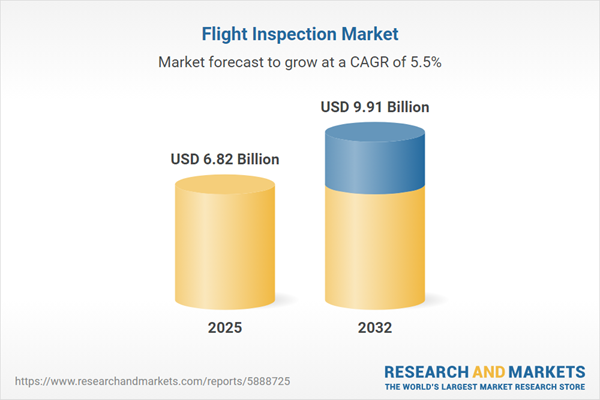Speak directly to the analyst to clarify any post sales queries you may have.
Senior leaders in aviation are responding to profound industry shifts as evolving regulations and technological innovations redefine the global flight inspection market. The need for compliant, forward-thinking strategies is driving focus on operational excellence and advanced safety practices.
Market Snapshot: Flight Inspection Market Analysis 2024–2032
The global flight inspection market is forecast to expand from USD 6.47 billion in 2024 to USD 6.82 billion in 2025 and reach USD 9.91 billion by 2032, reflecting a compound annual growth rate (CAGR) of 5.46%. Organizations worldwide are strengthening their flight inspection standards to address increasing regulatory requirements. This market climate is distinguished by rising investment in high-automation technologies, improved digital verification, and upgraded physical assets. Both established markets and emerging regions emphasize airspace safety and coordinated navigation to support evolving global aviation needs. Modernized inspection protocols are accelerating the adoption of harmonized operational standards and streamlining cross-regional and international alignment.
Scope & Segmentation: Detailed Outlook
This report provides a comprehensive framework for procurement, operations, and strategic planning leaders to evaluate market opportunities and competitive positioning. The segmentation below highlights focus areas and supports benchmarking resource allocation across the value chain:
- System Types: New communications, precision navigation aids, advanced landing guidance, surveillance, and modern weather detection platforms are sustaining increased inspection accuracy and operational reliability.
- Platform Types: The scope covers business jets, regional and narrow body aircraft, turboprops, rotorcraft (single/twin), as well as fixed-wing and multirotor unmanned aerial vehicles, enabling flexible inspection operations.
- Service Types: Scheduled, emergency, and on-demand inspections are essential to achieve compliance with evolving regulatory frameworks and to address new technical requirements.
- End Users: Civil aviation authorities, military stakeholders, manufacturers, and private sector operators are driving demand for robust, standards-aligned inspection capabilities in sensitive airspace.
- Applications: Solutions span in-flight assessments, post-maintenance verification, and preflight validations, ensuring oversight throughout the operational cycle and securing asset value.
- Regions: North America leads in technology and regulatory leadership. Asia-Pacific and Latin America increase infrastructure investment. Europe, Africa, and the Middle East adopt varied approaches, influenced by innovation hubs in the United States, Germany, China, and Australia.
- Key Companies: Major firms such as Honeywell International Inc., Northrop Grumman Corporation, Teledyne Technologies Incorporated, Thales Group, Indra Sistemas S.A., Raytheon Technologies Corporation, Lufthansa Technik AG, CAE Inc., Universal Avionics Systems Corporation, and Searidge Technologies Inc. continue to shape industry benchmarks and innovation trajectories.
Key Takeaways for Senior Decision-Makers
- Automation and sophisticated sensors enable more consistent and proactive monitoring, increasing the reliability of inspection processes across diverse fleets.
- Integrated cloud platforms and real-time analytics support predictive maintenance and optimized scheduling practices, reducing the incidence of unscheduled operational delays.
- Close cooperation with regulatory agencies and the mutual recognition of international standards simplify cross-border operations and drive greater consistency for multinational operators.
- The use of unmanned aerial systems and advanced remote tools expands inspection capabilities into challenging or controlled zones, improving responsiveness and flexibility.
- Pairing analytics-driven software platforms with advanced hardware reduces operational bottlenecks by standardizing workflows and supporting quality improvements.
- Modular and interoperable inspection systems make it easier for organizations to adapt to evolving infrastructure demands, facilitating scale and seamless integration.
Tariff Impact: Navigating Policy Adjustments in Flight Inspection Equipment
Updated U.S. tariffs on aerospace components have prompted the sector to reconfigure supply chain approaches. Companies are prioritizing regional manufacturing and cultivating resilient supplier networks to minimize risk exposure. Collaboration with regulators and technical partners is becoming more important for implementing unified protocols that mitigate potential interruption and maintain workflow stability amid changing policy environments.
Methodology & Data Sources
This analysis is based on direct interviews with technical leaders, regulatory stakeholders, and sector specialists, complemented by a comprehensive review of current aviation standards and published market data. The resulting methodology delivers decision-ready insights for navigating regulatory and technical change.
Why This Flight Inspection Market Report Matters
- This report distills current regulatory priorities and technological innovation, supporting senior decision-makers managing complex and evolving requirements.
- It serves as a benchmarking tool to help organizations assess strategies against broader industry developments, enabling risk-informed and resilient decision-making.
- Actionable recommendations assist in integrating new inspection solutions and in preparing for ongoing policy adjustments, enhancing operational agility and compliance.
Conclusion
This report is an essential resource for aviation executives seeking to navigate regulatory demands, optimize innovation planning, and strengthen operational strategies within the changing flight inspection landscape.
Additional Product Information:
- Purchase of this report includes 1 year online access with quarterly updates.
- This report can be updated on request. Please contact our Customer Experience team using the Ask a Question widget on our website.
Table of Contents
3. Executive Summary
4. Market Overview
7. Cumulative Impact of Artificial Intelligence 2025
Companies Mentioned
The companies profiled in this Flight Inspection market report include:- Honeywell International Inc.
- Northrop Grumman Corporation
- Teledyne Technologies Incorporated
- Thales Group
- Indra Sistemas, S.A.
- Raytheon Technologies Corporation
- Lufthansa Technik AG
- CAE Inc.
- Universal Avionics Systems Corporation
- Searidge Technologies Inc.
Table Information
| Report Attribute | Details |
|---|---|
| No. of Pages | 188 |
| Published | October 2025 |
| Forecast Period | 2025 - 2032 |
| Estimated Market Value ( USD | $ 6.82 Billion |
| Forecasted Market Value ( USD | $ 9.91 Billion |
| Compound Annual Growth Rate | 5.4% |
| Regions Covered | Global |
| No. of Companies Mentioned | 11 |









